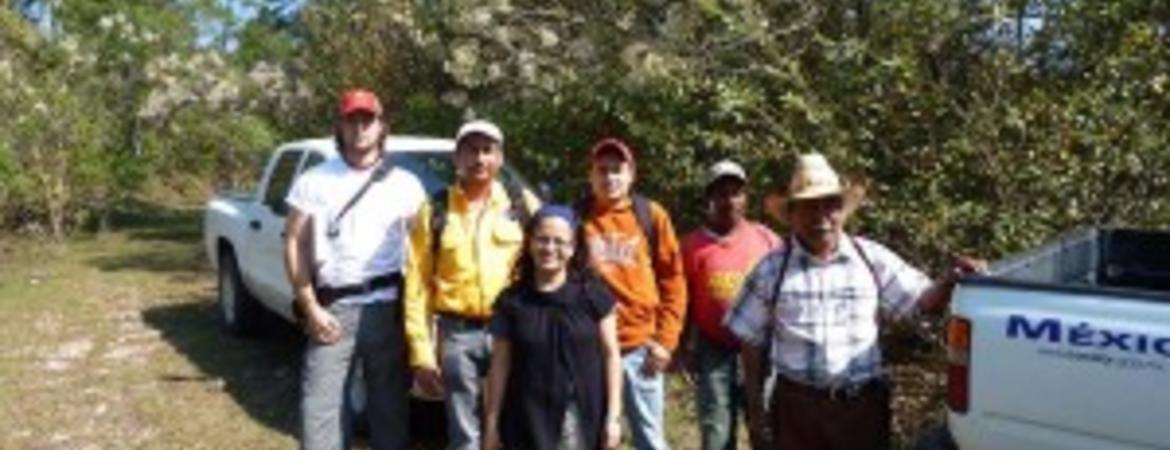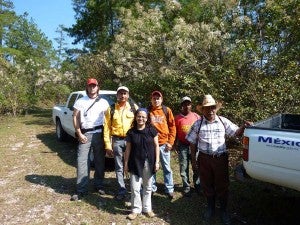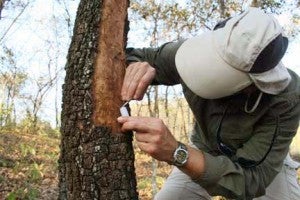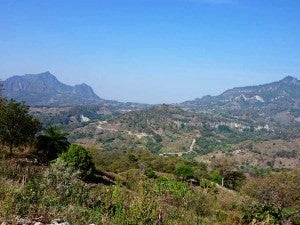
March 29 to April 10 2010

The gold spotted oak borer (GSOB), Agrilus coxalis(Coleoptera: Buprestidae) is an invasive pest in Southern California that was first detected around 2004. This beetle has a natural distribution that extends from the oak forests in the mountains of Southern Arizona (i.e., the Santa Ritas, Santa Catalinas, Chiricahuas, and the Huachucas), into Tamaulipas, Veracruz, Oaxaca, and Chiapas in Mexico and on into Verapaz in Northern Guatemala, and further South into Nicaragua. Specimens have also been collected from oaks in the Sierra de Laguna at the tip of the Baja Peninsula in Mexico. This beetle has not been collected frequently in its natural range which suggests that is naturally quite rare and likely does not exhibit high populations that kill thousands of oak trees.
The exact geographic range for GSOB is unknown, and the current known distribution reflects sporadic collections of adult beetles that were found by beating sampling oak foliage. There has been no systematic effort to accurately delineate the natural range of GSOB or to identify the oak species it exploits in its area of origin.
The epicenter of the GSOB infestation in Southern California is in the Cleveland National Forest in San Diego County. It is estimated that this pest has killed >20,000 native oak trees. Species belonging to the group known as red oaks are most preferred. California Live Oak, Quercus agrifolia, appears to be particularly vulnerable to attack. Oak species in the white oak group do not appear to be preferred hosts for GSOB.

GSOB larvae kill trees as they feed on the cambium, a thin section of living tissue found between the bark and the central wood of the tree. The cambium contains two layers, one that produces the bark to the outside of the tree, and the other that produces the water and food conducting tubes (xylem and phloem, respectively) and wood towards the inside of the tree. Feeding damage by tens or even hundreds of larvae in a single oak tree irreparably damages this sensitive tissue. Once damaged the tree cannot repair the broken xylem and phloem tubes and the oak slowly dies.
It is unknown how GSOB arrived in Southern California, or from where exactly it originated. A parsimonious assumption would be that the movement of infested oak firewood possibly from Southern Arizona, or perhaps Northern Mexico close to the California border may have accidentally introduced GSOB into the Cleveland National Forest. It is highly unlikely that GSOB crossed hundreds of miles of the Mojave Desert on its own. This natural barrier has likely prevented GSOB reaching Southern California in the past. However, infested logs in the back of a pick-up, or RV can readily traverse this inhospitable and host-free area, and rapidly move GSOB from its home range into suitable new habitat. Once this translocation happened the small founding GSOB population that emerged from infested logs likely found abundant host species that have no evolutionary resistance to this pest, and it is also likely that GSOB escaped its natural enemies that exploit it for food in the area in which it originated.

These two factors, vulnerable oak species with little to no natural immunity to GSOB attack, and lack of specialist natural enemies, coupled with a permissive climate and an abundance of hosts promoted the establishment and rapid proliferation of high density GSOB populations in Southern California.
The threat GSOB poses to the oak forests of California is immense. As this beetle kills oak trees it is modifying habitat that many native animals rely on. Some species have an exclusive relationship with oak forests and cannot survive without these trees. Dead trees are increasing the fuel load in areas that are already vulnerable to wild fires, and property values are adversely affected as majestic trees that shade homes or add landscape character are killed by GSOB.
The USDA Forest Service together with the University of California Riverside have launched a biological control program to find host specific natural enemies that can be imported and established in California for the control of GSOB. The exploration for natural enemies of GSOB is concentrating in areas where this pest is native. Surveys in Arizona have revealed that there are at least two species of parasitoid that attack GSOB larvae as they feed on oak trees.
Surveys for GSOB in Oaxaca and Chiapas in Mexico for GSOB and natural enemies with collaborators from ECOSUR and CONAFOR were completed in April 2010. GSOB larvae were found in oaks, but these finds were very uncommon. Only four infested oaks were found in two weeks of intensive searching in natural areas from which GSOB adults had been collected previously. Three of these four oaks only had 1-3 larvae in them, while one oak, which was dead, was heavily infested about 50 larvae were extracted.
This situation in Mexico is very similar to what has been observed in Arizona, also part of the natural range of GSOB – this beetle is very rare in its home range, GSOB densities in infested oaks are typically low, and dead and dying oaks with GSOB infestations are very uncommon. This could not contrast more strongly with the situation in Southern California where there are thousands of dead and dying oaks with GSOB infestations, and heavily infested trees can yield up to 200 larvae from one cut section!!
The GSOB larvae collected from trees in Mexico showed no obvious signs of parasitism. It is possible that the parasitoids attacking GSOB larvae and pupae in Mexico are endoparasitoids and live inside the GSOB larvae feeding on it. Collected GSOB larvae will need to be dissected in the lab to determine this. In Arizona, one of the most commonly encountered parasitoids is an ectoparasitoid, and these parasitoid larvae can be easily seen attached to the outside of GSOB larvae feeding.

Given the extraordinary GSOB infestations in Southern California, a strong approach may be required to bring this pest under successful biological control. Such an approach, if warranted, may necessitate the reconstruction of a guild of host-specific parasitoids that GSOB has not previously encountered throughout its natural range. For example, for successful GSOB biological control in California, ectoparasitoids from Arizona and possibly endoparasitoids from Mexico (assuming they exist) may both be needed to drive GSOB populations to the very low levels that are typical of the areas in which this insect evolved. This strategy of unique natural enemy combinations may overcome the apparent advantages GSOB enjoys in Southern California; hosts with high susceptibility to attack and favorable climates.
Unfortunately, an effective biocontrol solution to GSOB is not going to be found rapidly. Several years of work are needed to find, import, and screen natural enemies for safety in quarantine before they can be released for GSOB suppression in Southern California. During this intervening period, many thousands of oaks are likely to be killed by GSOB. The pest will continue to spread throughout California, either naturally over relatively short distances, or very rapidly over hundreds of miles should infested oak logs be moved from infested areas of Southern California into new areas (e.g., uninfested campgrounds in State and Federal Parklands).